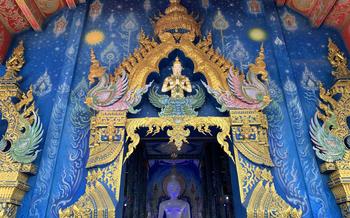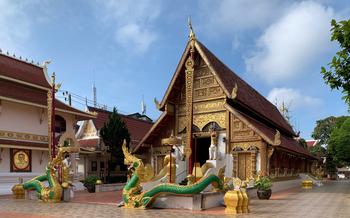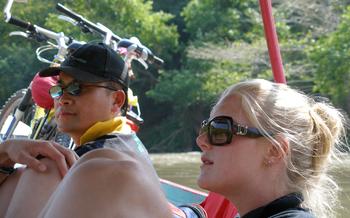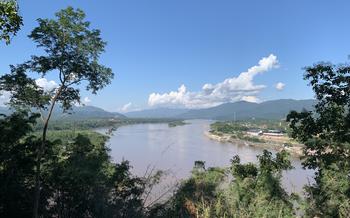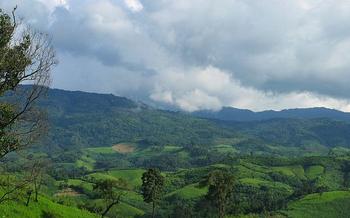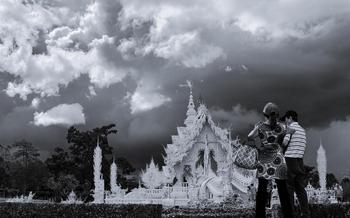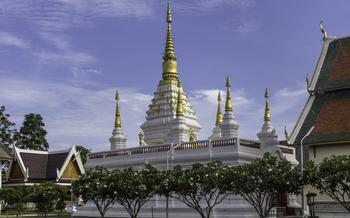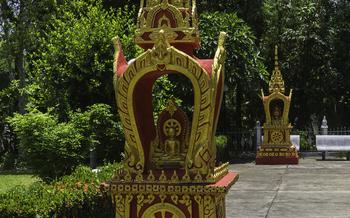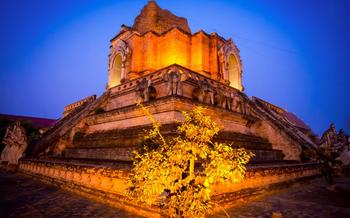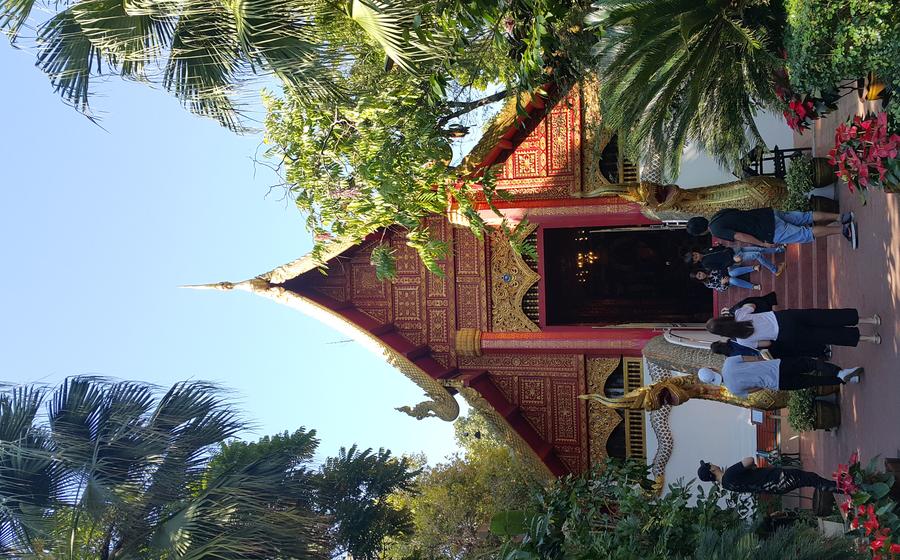
Wat Phra Kaew
- Historical Significance
- Exploring the Temple Grounds
- The Emerald Buddha
- Other Notable Buddha Images
- Mural Paintings and Artwork
- Architectural Features
- Devotional Practices
- Cultural Performances and Events
- Local Markets and Shopping
- Nearby Attractions
- Photography Tips
- Accessibility for Visitors with Disabilities
- Insider Tip: Unveiling Hidden Gems and Serene Moments
Historical Significance
Wat Phra Kaew, a sacred Buddhist temple in Chiang Rai, Thailand, holds immense historical and religious significance. Constructed in the 14th century, it is renowned as the former home of the Emerald Buddha, a revered statue considered the palladium of Thailand. The temple represents a blend of Lanna and Sukhothai architectural styles, reflecting the rich cultural heritage of the region.
The Emerald Buddha, carved from a single block of jade, is believed to have originated in India and traveled through several Southeast Asian kingdoms before finding its permanent home in Thailand. The statue's arrival in Chiang Rai marked a pivotal moment in Thai history, symbolizing the kingdom's growing power and prestige.
Throughout the centuries, Wat Phra Kaew has served as a significant center for religious devotion and cultural exchange. The temple's intricate architecture, adorned with exquisite murals and sculptures, reflects the deep-rooted Buddhist traditions and beliefs of the Thai people. It continues to be a place of pilgrimage for both local and international visitors, who come to pay homage to the Emerald Buddha and immerse themselves in the temple's spiritual ambiance.
Exploring the Temple Grounds
Wat Phra Kaew's sprawling grounds offer a journey through history, art, and spirituality. The layout of the temple complex reflects traditional Thai architecture, with central courtyards surrounded by various structures and shrines. As you step into the temple, you are greeted by a serene atmosphere that invites contemplation and reflection.
Notable structures within the grounds include the main chapel, which houses the revered Emerald Buddha. The chapel's intricate carvings and gilded stupas showcase the exquisite craftsmanship of Thai artisans. The surrounding galleries display a collection of Buddha images in various sizes and styles, each with its own unique symbolism and significance.
The temple's architecture is a harmonious blend of Thai, Burmese, and Lanna styles. Highlights include the impressive chedis, or stupas, which rise majestically towards the sky. The chedis are adorned with intricate designs and colorful tiles, symbolizing the path to enlightenment and the accumulation of merit.
Areas for meditation and prayer are scattered throughout the temple grounds, providing visitors with tranquil spaces for spiritual reflection. Visitors are welcome to sit in meditation or offer prayers at the designated shrines, following the customs and etiquette of the Buddhist tradition.
The Emerald Buddha
The Emerald Buddha is the most sacred and revered Buddha image in Thailand, embodying the country's deep-rooted Buddhist beliefs and cultural heritage. Carved from a single block of jade or emerald, the statue's origins are shrouded in mystery and legend, with various accounts tracing its creation to India, Sri Lanka, and Cambodia.
Standing at approximately 45 centimeters in height, the Emerald Buddha exudes an aura of serenity and divinity. Its intricate features, delicate proportions, and enigmatic smile have captivated millions of pilgrims and visitors throughout history. The statue is adorned with elaborate gold garments, precious stones, and a headdress, reflecting its immense religious and cultural significance.
The Emerald Buddha's journey to Thailand is steeped in folklore and historical narratives. According to legend, the statue was enshrined in a Cambodian temple for centuries before being taken to Laos by King Fa Ngum in the 14th century. It was later brought to Chiang Rai by King Sam Fang Kaen in the 15th century and eventually found its permanent home in Bangkok's Grand Palace in the 18th century.
The Emerald Buddha is not only a religious icon but also a symbol of Thailand's monarchy and national identity. It is believed to bring good fortune, prosperity, and protection to the kingdom, and its presence is considered a source of great pride and reverence among Thai people. The statue is the centerpiece of many royal ceremonies and festivals, attracting thousands of devotees and tourists each year.
When visiting Wat Phra Kaew, it is essential to observe proper etiquette and customs out of respect for the sacred nature of the Emerald Buddha. Visitors are expected to dress modestly and remove their shoes before entering the temple. Photography is strictly prohibited within the inner sanctum where the statue is enshrined.
The Emerald Buddha represents the heart and soul of Thai Buddhism, embodying the essence of compassion, wisdom, and spiritual enlightenment. Its presence at Wat Phra Kaew makes the temple a must-visit destination for anyone seeking a profound cultural and religious experience in Thailand.
Other Notable Buddha Images
Wat Phra Kaew is home to a diverse collection of Buddha images beyond the Emerald Buddha, each possessing unique artistic styles, materials, and historical significance. These Buddha images represent different periods of Thai art and craftsmanship, showcasing the evolution of Buddhist iconography.
One notable image is the Phra Buddha Sihing, crafted from a rare and precious alloy known as sihing. This Buddha image is revered for its exquisite craftsmanship and intricate details, embodying the grace and serenity of the Buddha.
Another significant image is the Phra Buddha Chinnarat, renowned for its serene expression and harmonious proportions. Carved from bronze, this Buddha image is considered one of the finest examples of Sukhothai art, capturing the essence of Thai Buddhist aesthetics.
Visitors can also admire the Phra Buddha Lanna, a colossal Buddha image crafted from white marble. This image represents the Lanna Kingdom's artistic heritage and is a testament to the region's rich cultural traditions.
Each of these Buddha images holds a special place in Thai history and culture, offering visitors a glimpse into the diverse expressions of Buddhist art and devotion. Photographing these images is a wonderful way to capture the beauty and spirituality of Wat Phra Kaew.
Mural Paintings and Artwork
Wat Phra Kaew is adorned with exquisite mural paintings that narrate tales from Buddhist mythology and depict scenes from Thai history and culture. These murals, rendered in vibrant colors and intricate detail, are a testament to the artistic prowess of Thai craftsmen. The walls of the temple come alive with stories of the Buddha's life, Jataka tales, and episodes from Thai folklore.
The murals, created using traditional techniques, showcase a harmonious blend of Thai, Chinese, and Indian influences. The artists employed a variety of natural pigments, including gold leaf, to achieve the rich and enduring hues that characterize these masterpieces. Each mural is a visual masterpiece, inviting viewers to immerse themselves in the stories and teachings they convey.
Beyond their artistic value, the murals at Wat Phra Kaew hold deep cultural and religious significance. They serve as a visual representation of Buddhist teachings, illustrating the path to enlightenment and the virtues of compassion, generosity, and wisdom. The murals also reflect the strong connection between Buddhism and Thai identity, showcasing the deep reverence and devotion of the Thai people.
Exploring the mural paintings at Wat Phra Kaew is a journey through time and tradition. Each mural tells a story, unveils a cultural insight, and offers a glimpse into the spiritual heart of Thailand. Take your time to admire these artistic treasures, and allow the vibrant colors and intricate details to transport you to another realm.
Architectural Features
The architectural style of Wat Phra Kaew is a blend of traditional Thai and Lanna influences, reflecting the region's rich cultural heritage. The most striking feature of the temple is its impressive viharn, or assembly hall, which houses the Emerald Buddha. The viharn features a graceful, curved roof adorned with intricate carvings and colorful tiles. The interior is adorned with exquisite murals depicting scenes from Buddhist mythology and the life of Buddha.
The temple grounds also boast several stupas, or bell-shaped structures, which serve as monuments to important Buddhist figures and events. These stupas are adorned with intricate carvings and colorful spires, adding to the temple's overall grandeur. The temple's chedis, or reliquary towers, are another notable architectural feature. These towering structures are believed to contain the relics of important Buddhist monks and are considered sacred by the faithful.
In addition to these main structures, Wat Phra Kaew features a variety of other architectural elements, including monasteries, meditation halls, and ordination halls. These structures are all designed in the traditional Lanna style, with curved roofs, intricate carvings, and colorful decorations. The harmonious blend of these architectural elements creates a visually stunning and spiritually uplifting environment that invites visitors to explore and reflect.
Devotional Practices
Wat Phra Kaew is not just a historical and architectural marvel; it is also an active center of Buddhist devotion and spirituality. Visitors are welcome to witness and participate in various religious rituals and ceremonies that take place within the temple grounds.
Observing Buddhist monks chanting prayers, meditating, or performing religious rituals can be a profoundly moving experience. Visitors can also make offerings of flowers, candles, or incense to the Buddha images, a symbolic gesture of gratitude and respect.
For those seeking a deeper spiritual connection, the temple provides opportunities for meditation and prayer. There are designated areas within the temple complex where visitors can find a quiet corner to sit and contemplate.
It is important to remember that Wat Phra Kaew is an active place of worship, and visitors should be respectful of the sacredness and serenity of the environment. Maintaining silence, dressing appropriately, and following the temple's customs and etiquette are essential for creating a harmonious and respectful atmosphere.
Cultural Performances and Events
Wat Phra Kaew is not just a site of religious devotion but also a vibrant hub for cultural performances and events that showcase the rich heritage of Thailand. Traditional Thai dance performances, known as khon, are regularly held within the temple grounds, offering visitors a glimpse into the kingdom's ancient storytelling traditions. These mesmerizing performances are characterized by elaborate costumes, intricate choreography, and captivating narratives that draw inspiration from Thai mythology and folklore.
The schedule of these performances can vary, so it's advisable to check the temple's website or inquire with local tourist information centers for the exact timings. Attending a khon performance at Wat Phra Kaew is an immersive experience that allows visitors to appreciate the artistry, grace, and cultural significance of this ancient form of dance.
Beyond khon performances, the temple also hosts other cultural events throughout the year, such as religious festivals, merit-making ceremonies, and ordination rituals. These events provide an opportunity for visitors to witness the deep-rooted spiritual traditions and vibrant community life that revolve around Wat Phra Kaew. Participating in these events, even as an observer, offers a deeper understanding of Thai culture and its reverence for Buddhism.
Local Markets and Shopping
Within a short walk from Wat Phra Kaew, visitors will find themselves immersed in a vibrant tapestry of local markets and shops. These bustling marketplaces offer a treasure trove of unique handicrafts, textiles, and traditional Thai souvenirs, providing an opportunity to support local artisans and take home a piece of Chiang Rai's rich cultural heritage.
One of the must-visit markets is the Chiang Rai Night Bazaar, located just a few minutes away from the temple. This lively market comes alive as the sun sets, offering a dazzling array of stalls selling everything from handmade jewelry and intricate wood carvings to colorful fabrics and traditional Thai clothing. Visitors can indulge in the art of bargaining and take pride in supporting the local community by purchasing directly from the talented craftspeople.
For those seeking a more tranquil shopping experience, the Chiang Rai Walking Street offers a charming ambiance with its quaint shops and boutiques. Here, visitors can browse through a carefully curated selection of locally made products, including ceramics, paintings, and unique home décor items. The walking street also features several cozy cafes and restaurants, inviting visitors to relax and savor the local flavors while immersing themselves in the authentic atmosphere.
Remember to embrace the local customs and traditions when shopping in Chiang Rai. A friendly smile and a polite greeting can go a long way in fostering a positive connection with the vendors. Don't be afraid to ask questions about the products and their origins, as many of the artisans are eager to share their stories and passion for their craft.
By venturing into the local markets and shops, visitors not only take home tangible souvenirs but also contribute to the preservation and continuation of Chiang Rai's rich cultural heritage. Whether it's a handwoven scarf, a intricately carved wooden figurine, or a piece of traditional Thai pottery, each purchase carries a unique story and connection to the local community.
Nearby Attractions
Wat Phra Kaew is not the only cultural treasure in Chiang Rai. The city and its surroundings offer a plethora of other attractions that complement a visit to the temple. The Clock Tower, a distinctive landmark in the city center, is a popular spot for taking photos and admiring the intricate artwork adorning its exterior.
For those interested in history, the Chiang Rai National Museum houses a collection of artifacts and exhibits showcasing the region's rich past. Several other temples in the vicinity, such as the Wat Phra Singh and the Wat Rong Khun, also merit exploration. The White Temple, as it is commonly known, is an unconventional and visually striking temple designed by the renowned artist Chalermchai Kositpipat.
If you have more time, consider embarking on a day trip to the Golden Triangle, where the borders of Thailand, Myanmar, and Laos meet. Here, you can visit the Hall of Opium, a museum dedicated to the history and impact of opium cultivation in the region. Nature enthusiasts can explore the Doi Tung Royal Villa, a former residence of the late Princess Mother Srinagarindra, set amidst stunning mountain scenery.
Chiang Rai is a city steeped in history and culture, and there is much to discover beyond the walls of Wat Phra Kaew. Take the opportunity to immerse yourself in the local heritage and explore the diverse attractions that this vibrant city has to offer.
Photography Tips
Capturing the beauty and spirituality of Wat Phra Kaew through photography requires careful consideration. Arrive early in the morning or late in the afternoon to take advantage of the soft, golden light that illuminates the temple's intricate details. Use a tripod to stabilize your camera and avoid blurry images, especially when photographing the Emerald Buddha or other sacred objects. Experiment with different angles and perspectives to showcase the temple's grandeur and unique features. Respect the sacred nature of the temple by avoiding intrusive or disrespectful photography and always ask permission before photographing people. Embrace the opportunity to capture the essence and serenity of this revered site, creating lasting memories of your visit to Wat Phra Kaew.
Accessibility for Visitors with Disabilities
Wat Phra Kaew is committed to providing an inclusive and accessible experience for all visitors, including those with disabilities. The temple grounds are wheelchair accessible, with ramps and gentle slopes connecting different areas. Accessible restrooms are available on-site, ensuring the comfort and convenience of visitors with special needs.
To ensure a seamless experience, visitors with disabilities are encouraged to plan their visit in advance and inform the temple staff of any specific requirements or assistance they may need. This will allow the staff to make necessary arrangements and provide personalized assistance to facilitate a comfortable and enjoyable visit.
For visitors with hearing impairments, assistive listening devices or sign language interpreters can be arranged upon request. The temple staff is dedicated to creating an environment where everyone feels welcome and respected, regardless of their abilities.
Insider Tip: Unveiling Hidden Gems and Serene Moments
Beyond the main attractions of Wat Phra Kaew, there are hidden corners and secret spots that offer a tranquil respite from the crowds. Explore the serene gardens, where you can find secluded benches nestled amidst lush greenery, providing a peaceful haven for contemplation and reflection.
For a unique perspective, climb the ancient stairs leading to the temple's upper terrace. From this vantage point, you'll be rewarded with breathtaking panoramic views of the temple complex and the surrounding landscape.
To capture the essence of Wat Phra Kaew's spirituality, visit during the early morning hours or late afternoon, when the soft golden light casts a magical glow on the temple's architecture. Embrace the serenity of the temple's atmosphere and immerse yourself in the tranquility of this sacred space.

